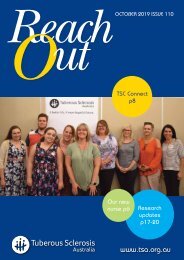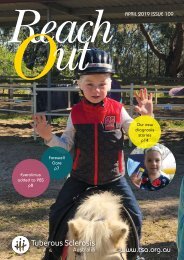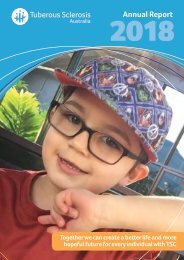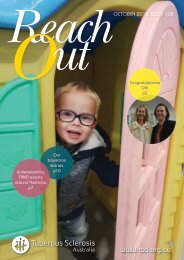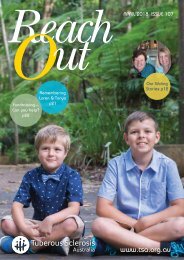Tuberous Sclerosis Australia Reach Out Magazine October 2016
Create successful ePaper yourself
Turn your PDF publications into a flip-book with our unique Google optimized e-Paper software.
Personal Stories<br />
Personal Stories<br />
Bump head hospital ow!<br />
Liam’s epilepsy surgery<br />
Selina Spowat. Selina writes about her family<br />
at www.happychinblog.wordpress.com<br />
’ve got a great idea,” I said to my husband in 2013.<br />
“I“Let’s gather all the things Liam hates most in one<br />
place – loud noises and bright lights, needles, tubes and<br />
wires randomly inserted in or attached to him by people<br />
he doesn’t know, pain he doesn’t understand, little or<br />
no control over what’s going to happen next, bad food,<br />
uncomfortable beds and no access to a nearby fridge. Then<br />
let’s take him to spend three weeks there.”<br />
No, I didn’t really say this, but I might as well have.<br />
Because we were going to hospital for a major operation on<br />
Liam’s brain.<br />
Any parent who’s ever been in hospital with a child knows<br />
exactly how stressful it is. We’d only ever been for MRIs,<br />
but these were conducted under general anaesthetic, usually<br />
involving one of us sitting on Liam while the other pinned<br />
his legs down, the anaesthetist ducking and weaving like<br />
Muhammed Ali trying to get the cannula in. The bigger Liam<br />
got, the harder it became to get him under, so the drug payload<br />
kept getting ramped up.<br />
This was an operation that would<br />
take 12 hours and would open his whole<br />
brain in an attempt to remove a large<br />
tuber on his right frontal lobe<br />
But major neurosurgery was another thing altogether. This<br />
was an operation that would take 12 hours and would open his<br />
whole brain in an attempt to remove a large tuber on his right<br />
frontal lobe, which appeared to be the source of his seizures. EEG<br />
wires would be attached to the tuber and MRI tests conducted<br />
throughout the operation to make sure the surgeon got as much of<br />
the tuber as possible, along with any other smaller ones showing<br />
up on the scans. If successful, the operation could dramatically<br />
reduce Liam’s seizures and give him a much better quality of<br />
life. However, it was carefully explained to us that even with<br />
the offending tubers gone, he might still experience seizures, as<br />
the brain had 18 years of deeply ingrained seizure patterns. We<br />
weren’t to hope for developmental changes, that ship had sailed<br />
for Liam, we were told.<br />
We decided to be optimistic. Even if we could eventually<br />
wean him off some of his anti-convulsants, surely that would<br />
be worth it for him? The side effects from these drugs were<br />
many and unpleasant.<br />
How little we knew of what was to come in the weeks<br />
ahead, and how fortunate we didn’t know! I for one would<br />
never have had the courage to go ahead. If I had known, I also<br />
would have packed:<br />
• Valium (because you can’t really go taking your child’s<br />
Valium in the hospital, it’s not a good look)<br />
• Three weeks’ worth of home-cooked meals in<br />
takeaway containers<br />
• My mother (she had sadly died seven years earlier, but boy<br />
she would’ve been handy to have! My sister did fly down<br />
from Queensland for five days which was brilliant, but more<br />
on that later)<br />
• At least 25 dolphin and fish shaped helium party balloons<br />
• Two of those big puffy jackets for us to wear (Liam scratched<br />
the hell out of our arms during the first week while he was<br />
fighting whatever procedure it was he didn’t want)<br />
• A really experienced psych nurse, preferably one with a good<br />
working knowledge of the Vulcan nerve pinch. We were<br />
actually assigned a psych nurse after the third day, as things<br />
had gotten pretty hairy by then, but Liam promptly decided<br />
to settle down and the poor man just sat outside the room,<br />
waiting for something to happen and listening to music on<br />
his iPod<br />
• The Wiggles (only for the first two or three days, to distract<br />
Liam from ripping off his bandages. I reckon we might not have<br />
had to splint his arms to the bed if the Wiggles had been there)<br />
• Bob the Builder (to repair all the bits of the hospital<br />
that he broke)<br />
• Bob the Bartender (for me and my husband)<br />
• A suitcase full of chocolates for the incredible nursing staff<br />
In any event, to borrow a line from Marvin the Paranoid<br />
Android, the first three million years were the worst. Actually,<br />
it was more like three days, but time goes very slowly in<br />
hospital. Our brave boy had come through like a trooper, with<br />
a tuber the size of a plum removed that had been sparking off<br />
seizure activity every two minutes. Imagine living with that for<br />
18 years! Every time you went to do or think something you’d<br />
be interrupted by brain noise, a kind of 24 hour insomnia. A<br />
Grand Central Station of the mind.<br />
The first three days post-surgery included Liam ripping his<br />
surgical dressing off, pulling out his arterial IV line and being<br />
so puffy his eyes swelled shut. But by day four and five, Liam<br />
was back. No longer encumbered with bandages and drips, he<br />
was free to wander about the ward.<br />
The Paediatric Neurology nurses at Melbourne Children’s<br />
are some of the most flexible, unflappable, innovative and<br />
compassionate people I have ever met. At every stage they<br />
worked with us to create solutions, they were calm and they<br />
listened. They asked us our opinion, and were genuinely<br />
receptive to suggestions. We were forced to be extremely<br />
creative with Liam’s care, some things (like an ECG) were<br />
just impossible, but even though he was without a doubt<br />
an extremely challenging patient, we never felt it was any<br />
bother to them. My hat was off to them three years ago and<br />
it remains off. I must remember to give them a pay rise when<br />
I’m in charge.<br />
Nearly three years on, Liam still has his zigzag scar as a<br />
reminder of that harrowing couple of weeks. When he looks<br />
back at photos of the trip he says “Bump head hospital ow!”<br />
I don’t think he understands what an ‘operation’ is. He thinks<br />
he bumped his head and woke up with an ‘Ow’ in hospital.<br />
The first MRI scan (under general anaesthetic) after<br />
neurosurgery was fairly fraught. By his level of agitation<br />
beforehand, I’m sure Liam thought he was going to bump<br />
his head again while he was under and wake up splinted to<br />
the bed, with a 10 inch scar and tubes everywhere. He’s had<br />
three general anaesthetics since then, and the memory is<br />
slowly fading.<br />
While we were in hospital I met a mother whose 16 year<br />
old son had a brain tumour. They’d been through four lots of<br />
neurosurgery in three years. The prognosis wasn’t good. I can’t<br />
even imagine what that must have been like. We feel very lucky<br />
to have our Liam well and bouncing round the place, being<br />
weaned off so many medications that are no longer necessary.<br />
Despite the neurologist’s prediction (or perhaps because of it,<br />
Liam doesn’t like being told he can’t do stuff), he has made<br />
some major developmental leaps, has improved language<br />
and communication skills and his aggressive behaviours are<br />
massively reduced.<br />
We had to fight hard to get him this life changing operation<br />
and it was without doubt the hardest three weeks of my life. On<br />
several occasions we just broke down and cried together over<br />
what we had done to our boy. Even now, the sight of that scar<br />
can reduce us both to tears.<br />
At one particularly low point I remember thinking, “This<br />
is much too hard. I can’t do this anymore, I’ve changed my<br />
mind.” But we got through it, and as a result I’m not much<br />
scared of tough things anymore.<br />
10<br />
<strong>Reach</strong><br />
<strong>Out</strong><br />
OCTOBER <strong>2016</strong> ISSUE 104<br />
11


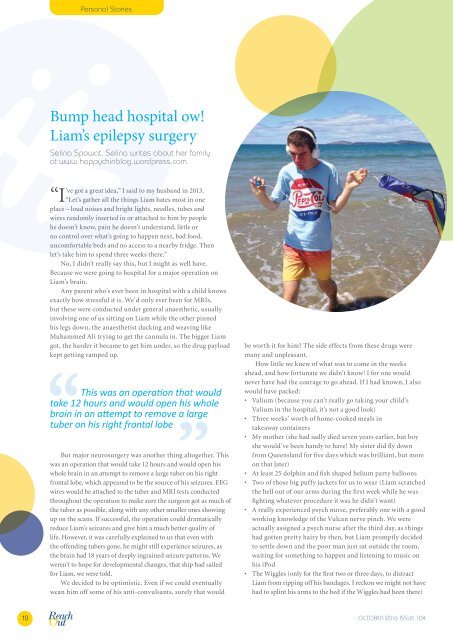


![TSA Reach Out April 2022 [Final]](https://documents.yumpu.com/000/066/687/587/3d369bd665bdb406a759500f62e2cfad0ccb7b3d/47512b4a703265727550565249426664566a727454513d3d/396a524e7354316d3867454b587243526164724c52673d3d.jpg?AWSAccessKeyId=AKIAICNEWSPSEKTJ5M3Q&Expires=1714370400&Signature=x8tVRf7QBvjpshnJqlclT4vtvrg%3D)
![TSA AR 2021 [WEB] (1)_FINAL](https://documents.yumpu.com/000/065/886/431/1afb21934ac6c444cd384e5fd7403d62e47080ce/426853747566526573646568546777594b4a4a5734513d3d/547274595943503850786275754544495972536c52513d3d.jpg?AWSAccessKeyId=AKIAICNEWSPSEKTJ5M3Q&Expires=1714370400&Signature=YwZ8G4qbcZCV0bFtPhp0d%2FUqxqs%3D)

![TSA Reach Out Apr 2021 [WEB]](https://documents.yumpu.com/000/065/442/909/1e583cb2acba0eaa7f1aae53e14a0cf408aa56c4/7871796d694459464d707163324830746459484671673d3d/45356637637a3369494f764f4c3858495549795251513d3d.jpg?AWSAccessKeyId=AKIAICNEWSPSEKTJ5M3Q&Expires=1714370400&Signature=OiFIYjs%2BNVGiuxb4P7qYSSk%2BgP4%3D)




